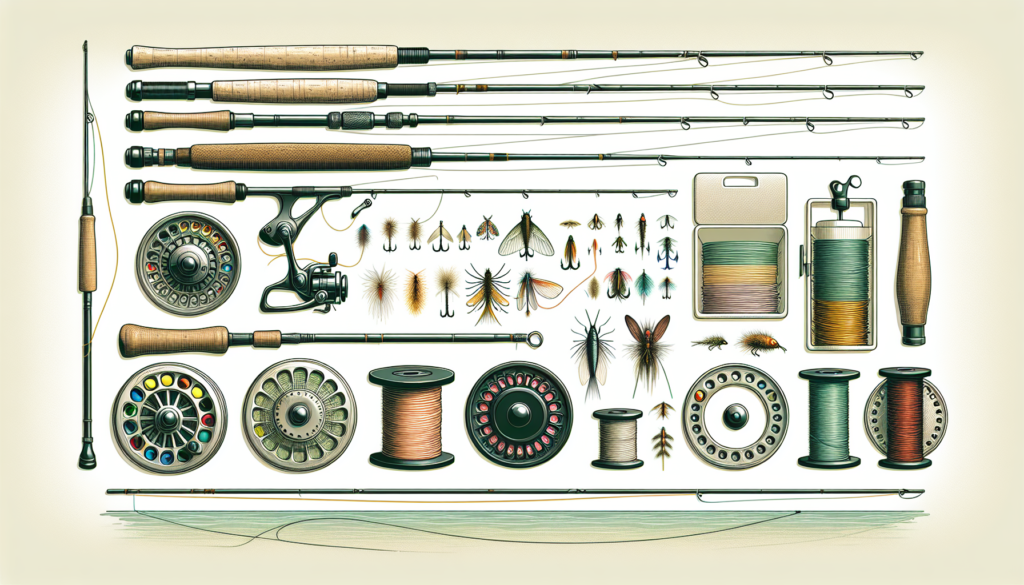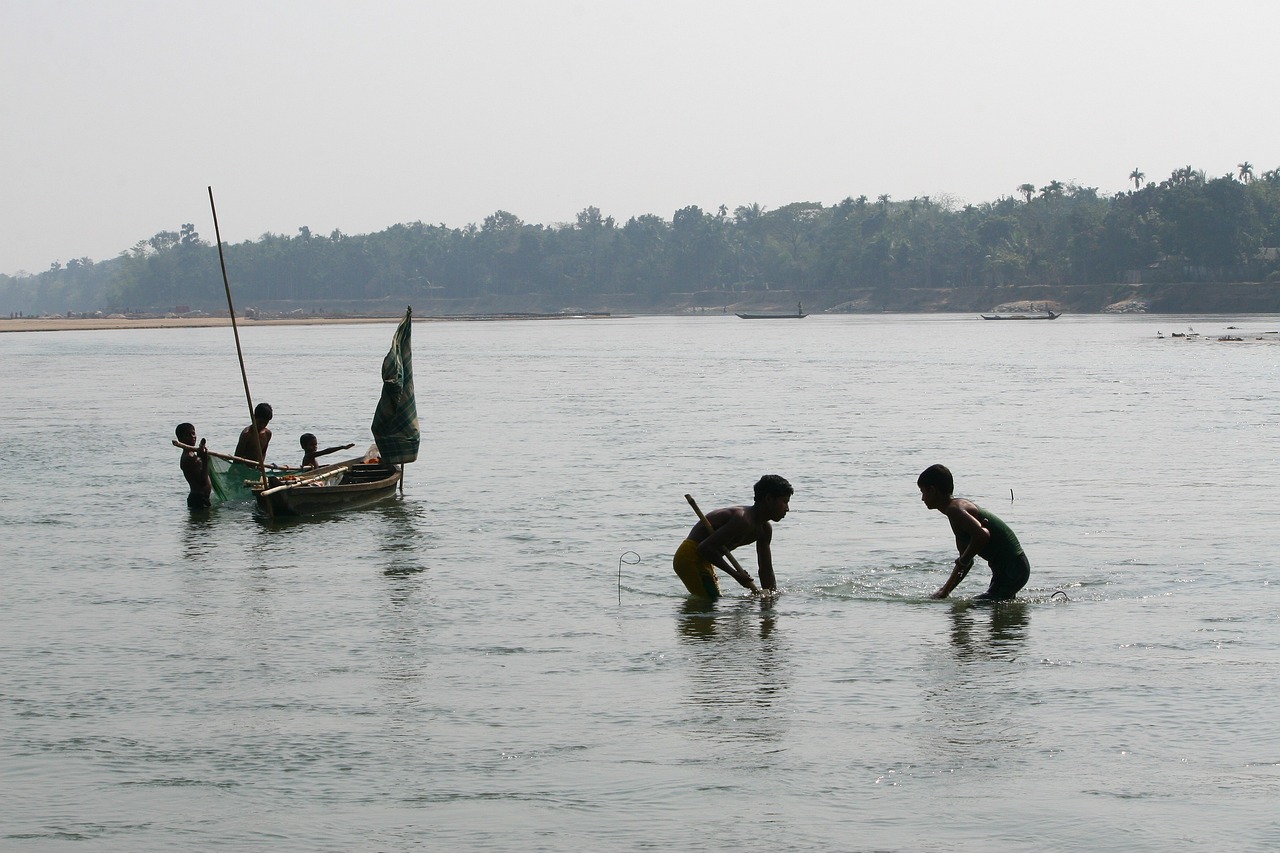Whether you’re a seasoned angler or a beginner looking to try out a new fishing technique, understanding the basics of fly fishing setup is essential. In this article, we will provide you with a comprehensive overview of the fundamental components required for a successful fly fishing experience. From rods and reels to lines and flies, we’ll guide you through the essential equipment needed to get started in this exciting and rewarding sport. So grab your gear and let’s dive into the world of fly fishing!
Rod and Reel
Selecting a Fly Rod
When it comes to selecting a fly rod, there are a few factors to consider. First and foremost, you’ll want to determine the appropriate rod weight for the type of fishing you plan on doing. Each rod weight is designed to cast a specific range of fly sizes, so it’s important to match the weight to the flies you’ll be using. Additionally, you’ll want to consider the length of the rod. Longer rods provide increased line control and casting distance, while shorter rods offer better maneuverability in tight spaces. Lastly, think about the material and action of the rod. Graphite rods are lightweight and sensitive, while fiberglass rods offer a slower action that can be forgiving for beginners.
Choosing a Reel
Choosing the right fly reel is just as important as selecting a rod. The reel serves as a vital component for storing fly line and providing drag when reeling in a fish. Consider the size and weight of the reel in relation to the rod you’ve selected. The reel should balance properly with the rod to provide a comfortable fishing experience. Additionally, be sure to choose a reel with a smooth and reliable drag system. This will prevent fish from breaking your tippet and give you more control during a fight.
Matching the Rod and Reel
Once you’ve chosen your fly rod and reel, it’s crucial to ensure that they are a proper match. The weight of the reel should complement the weight of the rod to create a balanced setup. A properly balanced rod and reel combination will allow for better casting accuracy and control. Take the time to test different reels on your chosen rod before making a final decision. It’s also important to consider your fishing conditions and target species when matching a rod and reel. Lighter setups are ideal for small streams and delicate presentations, while heavier setups are better suited for larger fish and stronger currents.
Fly Line
Understanding Fly Line Weight
Understanding the weight of fly line is essential in fly fishing. Fly line weight refers to the thickness and density of the line, which affects its ability to carry the weight of the fly during casting. The weight of the line should match the weight of the rod and reel to create a balanced system. Heavier weight lines are best for larger flies and windy conditions, while lighter weight lines are suitable for smaller flies and calm conditions. It’s important to consult the manufacturer’s guidelines or seek advice from experienced anglers to determine the appropriate line weight for your setup.
Types of Fly Line
There are different types of fly lines available, each designed for specific fishing conditions and techniques. Floating lines are the most common and are used for surface fishing. They are easy to cast and control, making them ideal for beginners. Sink-tip lines have a sinking section at the tip, allowing you to present flies at various depths. These lines are often used when fishing in streams or lakes with a consistent depth. Full sinking lines are designed to sink completely, allowing you to reach fish at deeper depths. These lines are commonly used for fishing in deep lakes or rivers with swift currents.
Choosing the Right Fly Line
When choosing the right fly line, consider the type of fishing you’ll be doing and the size of the flies you’ll be using. Floating lines are versatile and suitable for a wide range of fishing situations, making them a great choice for beginners. If you plan on fishing in deeper water or need to get your flies down to a specific depth, sink-tip or full sinking lines may be more appropriate. Additionally, consider the water conditions and species you’re targeting. Different species of fish may require different presentation techniques, and certain types of lines may be better suited for specific water temperatures or currents. Research and seek advice from experts to ensure you select the right fly line for your needs.
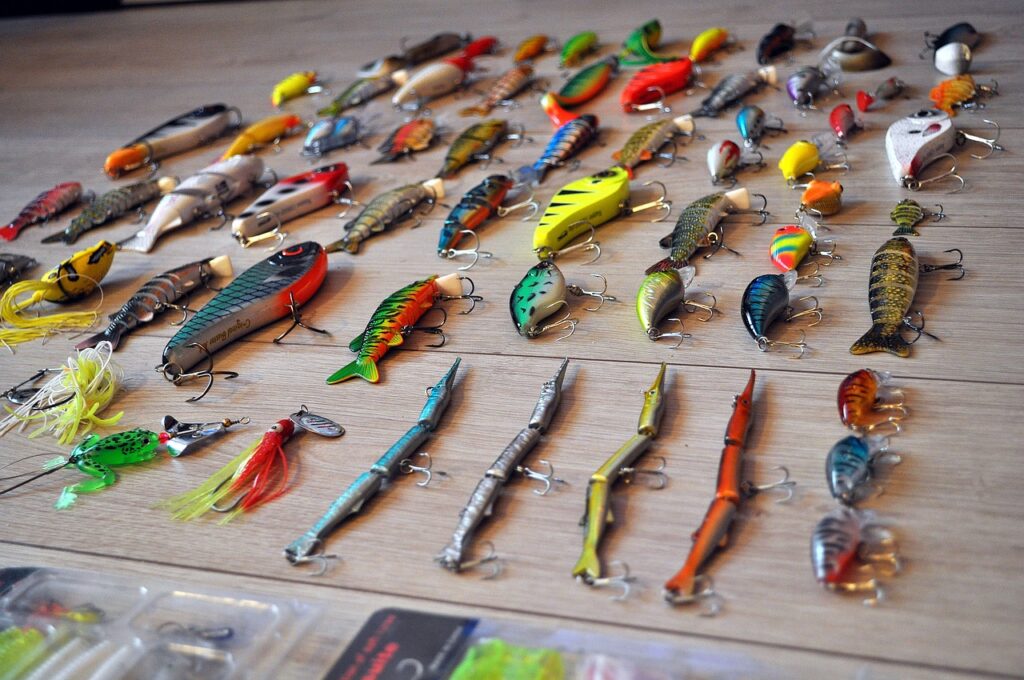
Backing
What is Backing?
Backing is a durable and thin line that is attached to the fly reel before attaching the fly line. Its primary purpose is to provide extra length of line in case a fish takes an extended run and runs out of the fly line on the reel. Think of backing as an insurance policy that allows you to maintain a connection with the fish even if it exceeds the length of your fly line. Backing is usually made of braided Dacron or similar materials, ensuring it has sufficient strength and resistance to abrasion.
Choosing the Right Backing Material
When choosing the right backing material, consider the strength and diameter of the line. The strength should be strong enough to handle the fish species you’re targeting, as well as any unexpected encounters with larger fish. The diameter of the backing should be thin enough to offer a large amount of line capacity on the reel, allowing you to have enough backing to handle those long, fast runs. It’s also important to choose a backing material that resists rot, UV damage, and abrasion. This will ensure its longevity and reliability throughout your fishing adventures.
Attaching Backing to the Reel
Attaching backing to the reel is a simple process that requires a few basic steps. Start by tying a secure knot at the end of the backing, creating a loop or a knot with a loop at the end. The loop will allow you to connect the backing to the reel more easily. Next, insert the backing through the arbor of the reel and make several wraps around the spool. Ensure that the wraps are tight and even. After the wraps, tie another secure knot or use a backing connection device to secure the backing to the reel. Once the backing is attached, you can then attach the fly line to the backing using a loop-to-loop connection or a nail knot.
Leader and Tippet
Understanding Leaders and Tippets
Leaders and tippets are essential components of a fly fishing setup. The leader is a tapered section of monofilament or fluorocarbon line that connects the fly line to the tippet. It allows for a smooth transfer of energy during casting and provides a nearly invisible connection to the fly. The tippet is a thin section of line that is attached to the end of the leader. It serves as the connection between the fly and the leader and is usually made of fluorocarbon for its low visibility in the water.
Types of Leaders and Tippets
Leaders and tippets come in various lengths and sizes to accommodate different fishing situations. The length of the leader depends on factors such as water clarity, fish behavior, and the type of flies you’ll be using. In general, longer leaders are better for clear water and spooky fish, while shorter leaders are suitable for faster currents and heavier flies. Tippet size refers to the diameter of the line and is numbered from thickest to thinnest (e.g., 0X, 1X, 2X, etc.). The tippet size should match the weight of the fly and the size of the fish you’re targeting. Thicker tippets are stronger but may be more visible in the water, while thinner tippets offer better presentation but may break more easily.
Setting up the Leader and Tippet
Setting up the leader and tippet involves attaching the tippet to the end of the leader and then attaching the fly to the tippet. To attach the tippet, use a blood knot or a surgeon’s knot to create a secure connection. Ensure that the knot is strong and smooth, as any roughness can cause the tippet to break when fighting a fish. Once the tippet is attached, you can then attach the fly using a clinch knot or an improved clinch knot. Practice these knots beforehand to ensure you can tie them quickly and effectively on the water.
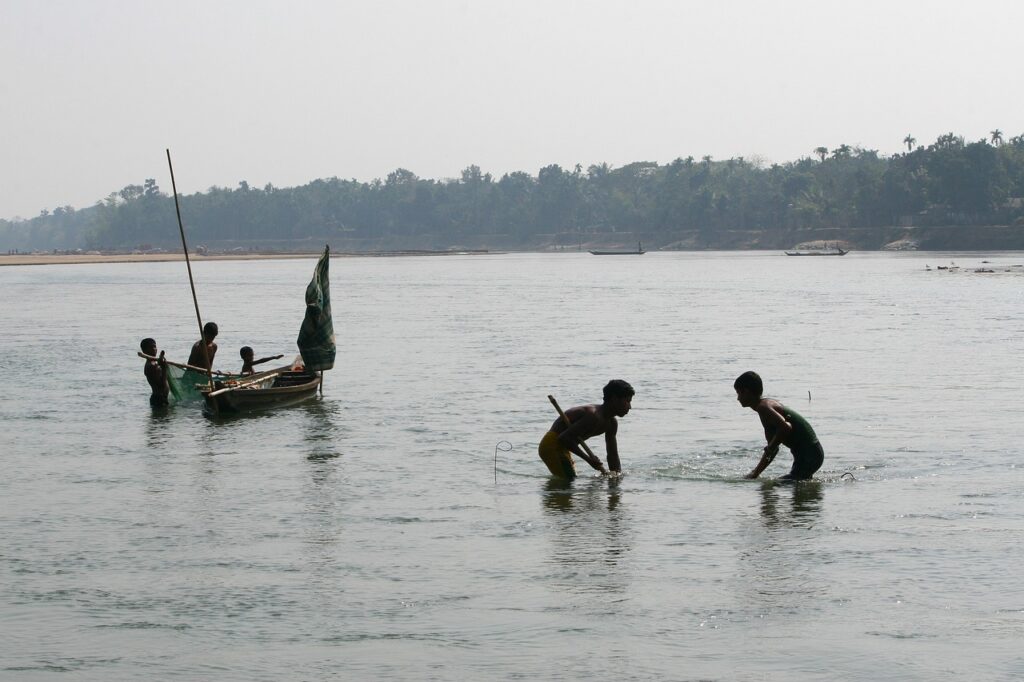
Flies
Different Types of Flies
Flies come in a wide range of designs and styles, each imitating a specific type of insect, baitfish, or other food source for fish. Dry flies are designed to float on the surface of the water and imitate insects that fish feed on. Wet flies, on the other hand, are designed to sink below the surface and imitate nymphs or other underwater food sources. Streamers are larger flies that imitate baitfish or minnows and are often used to target predatory fish. Lastly, there are specialty flies, such as terrestrials or attractor patterns, which don’t imitate any specific insect but can still be effective in certain situations.
Selecting Flies for Different Conditions
Selecting flies for different conditions involves understanding the local insect life and the feeding patterns of the fish. Pay attention to the type of insects that are present in the area you’ll be fishing and try to match your fly selection accordingly. If you’re unsure of the specific insects, choose flies that have a general resemblance to common food sources such as mayflies, caddisflies, or midges. Additionally, consider the water conditions and the behavior of the fish. If the fish are actively rising to feed on the surface, using dry flies would be an appropriate choice. If the fish are feeding underwater or near the bottom, nymphs or streamers would be better options.
Organizing Your Fly Collection
Organizing your fly collection is essential for easy access and efficient fly changes on the water. Consider using fly boxes with multiple compartments to separate different types of flies. You can organize them by fly type, fly size, or even by specific insect patterns. Labeling the compartments or using different color-coded boxes can also help you quickly identify the flies you need. It’s important to take note of the flies you’re using and the ones that are most effective in specific conditions. This will allow you to build a comprehensive and versatile collection over time.
Knots
Essential Fly Fishing Knots
There are a few essential fly fishing knots that every angler should know. The clinch knot is used to attach the leader or tippet to the fly, while the improved clinch knot provides extra security by adding an extra turn to the basic clinch knot. The blood knot is used to attach two sections of monofilament together, such as connecting different sizes of tippets. The surgeon’s knot is a versatile knot that can be used for attaching tippets, leaders, or backing. Lastly, the nail knot is commonly used to attach the fly line to the leader. Practice these knots until you can tie them confidently and quickly on the water.
Tying the Perfect Knots
Tying the perfect knots requires practice and attention to detail. Ensure that each knot is tied correctly and securely, as a weak knot can result in lost fish. When tying knots, it’s important to moisten the line with saliva or water before tightening them. This will reduce friction and ensure that the knots seat properly. Take your time when tying knots and avoid rushing, especially when tying knots in low-light conditions or when your hands are cold. For added security, give each knot a final pull and inspect them before casting. Regular practice and familiarity with different knots will help you tie them quickly and confidently in various fishing situations.
Practice and Mastery
Becoming proficient in tying knots requires practice and repetition. Set aside dedicated time to practice tying knots, both at home and on the water. Practice tying knots with different line types and sizes, as they may require slight adjustments in technique. Challenge yourself by tying knots in low-light conditions or with gloves on to mimic challenging fishing situations. Additionally, seek guidance from experienced anglers or attend fly fishing workshops to learn new tips and techniques for knot tying. With enough practice and dedication, you’ll achieve mastery and be able to tie knots quickly and effectively, even in difficult fishing conditions.
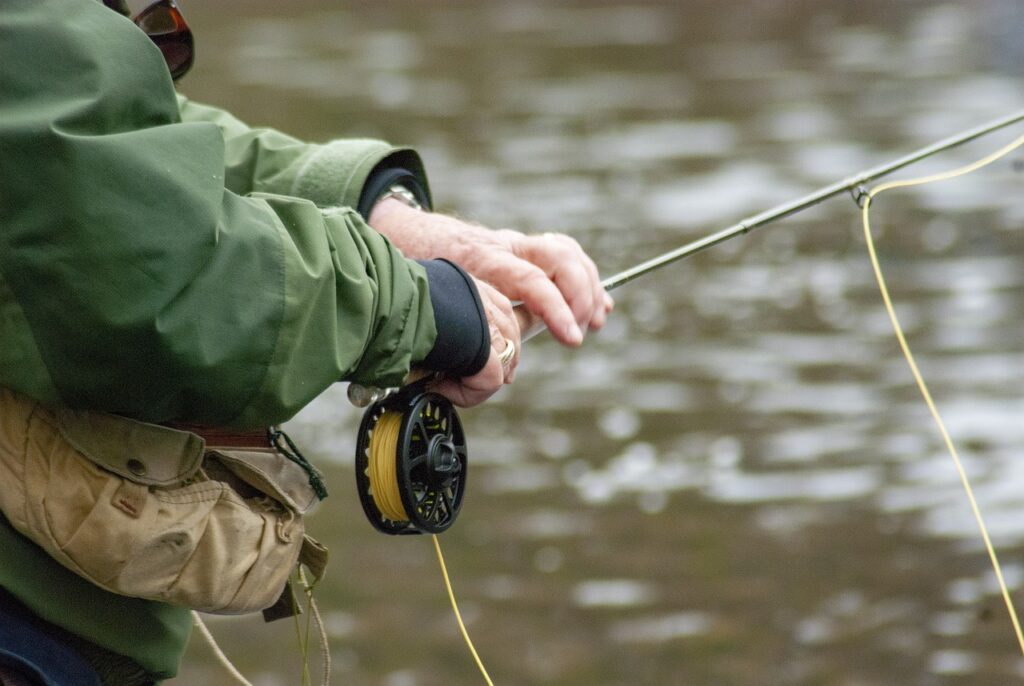
Fly Fishing Gear
Waders and Boots
Waders and boots are essential gear for fly fishers who plan on wading into the water. Waders are waterproof pants that keep you dry while fishing in rivers, streams, or lakes. They are typically made of breathable materials that allow moisture to escape, preventing you from getting sweaty and uncomfortable. When selecting waders, consider the material, fit, and features such as built-in gravel guards or reinforced knees. Boots, on the other hand, are designed to be worn over the waders to provide traction and support while wading. Choose boots with sturdy soles and good ankle support to ensure stability on slippery rocks and uneven terrain.
Vests and Packs
Vests and packs are used to carry and organize your fly fishing gear while on the water. Vests offer a traditional and convenient way to carry essential items such as flies, leaders, tippets, and tools. Look for vests with multiple pockets and compartments to keep everything easily accessible. Some vests also offer features like built-in retractors for tools or hydration bladder compatibility. Packs, on the other hand, are worn like a backpack and provide more storage space for larger gear or extra layers. They are ideal for anglers who want to carry a camera, rain jacket, or other non-essential items. Choose a vest or pack that suits your personal preferences and fishing style.
Accessories
In addition to the essential gear, there are various accessories that can enhance your fly fishing experience. Polarized sunglasses are a must-have accessory as they reduce glare and allow you to see fish and potential hazards beneath the water’s surface. Fly fishing nets are useful for safely landing and releasing fish without causing unnecessary harm. Fly boxes are essential for organizing and storing your flies, as previously mentioned. Other useful accessories include forceps or hemostats for removing hooks, nippers or scissors for cutting line, and a hat or buff for sun protection. Consider your personal needs and fishing conditions to determine which accessories will be most beneficial for you.
Casting Techniques
Basic Casting Techniques
Mastering basic casting techniques is fundamental to successful fly fishing. The overhead cast is the most common and versatile casting technique used in fly fishing. It involves a fluid motion of the fly rod, creating a backcast and a forward cast to propel the line and the fly through the air. The roll cast is another essential technique, commonly used in tight spaces or when dealing with obstacles behind you. It relies on a circular motion of the rod to pick up the line from the water and cast it forward. Practice these basic casting techniques in an open area to develop accuracy, distance, and presentation.
Improving Your Casting Skills
Improving your casting skills requires practice and focus on specific aspects of your casting technique. Start by focusing on your grip and stance, ensuring that you have a firm yet relaxed grip on the rod and that your body is properly aligned with your target. Next, work on your timing and tempo, aiming for a smooth and consistent casting stroke. Keep your wrist firm and use your forearm and shoulder to generate power and control. Practice casting in different casting planes, such as sidearm or high overhead, to increase your versatility and adaptability on the water. Seek feedback from experienced anglers or consider taking casting lessons to refine your technique further.
Advanced Casting Techniques
Once you’ve mastered the basic casting techniques, you can explore advanced casting techniques to expand your skill set. The double haul is a technique used to increase line speed and distance and is commonly employed in windy conditions. It involves a simultaneous pull on the line with the non-casting hand as you accelerate the rod during the cast. The reach cast is a useful technique for presenting your fly to a specific target while keeping your line and leader away from the fish. It involves extending your casting arm towards the target and then making the cast with a slight reach to the side. Practice these advanced techniques in various fishing scenarios to improve your versatility and increase your chances of success.
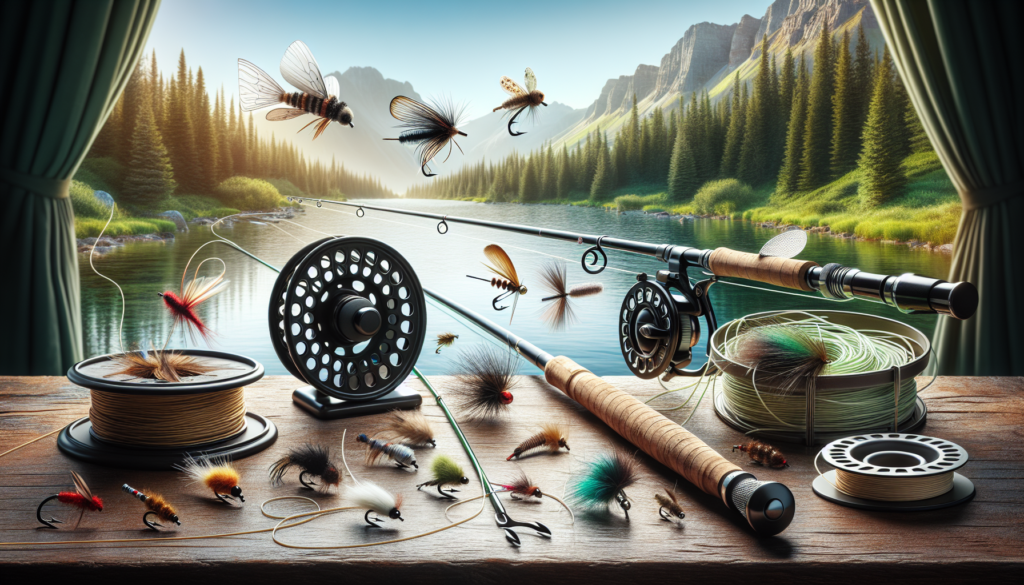
Understanding Fish Behavior
Reading Water
Understanding how to read water is essential in finding fish and presenting your flies effectively. Start by observing the features of the water, such as currents, eddies, and riffles. These features indicate changes in the water’s current speed and depth, which can affect where fish are likely to be holding. Look for areas of slower currents or pockets behind rocks where fish may seek shelter or conserve energy. Additionally, pay attention to any surface disturbances or rising fish, as this can indicate feeding activity. By understanding how to read water, you can better target your casts and increase your chances of enticing a strike.
Identifying Fish Habitats
Identifying fish habitats is crucial for locating fish and understanding their behavior. Different species of fish have specific habitat preferences depending on factors such as temperature, oxygen levels, and food availability. Look for areas with underwater structure, such as rocks, logs, or submerged vegetation, as these provide cover and hiding spots for fish. Shallow flats or weed beds can attract fish that are feeding on insects or small baitfish. Deep pools or runs can provide refuge for larger fish seeking cooler temperatures or resting areas. Study the behavior and preferences of the fish species you’re targeting to locate their preferred habitats and increase your chances of success.
Observing Fish Movement
Observing fish movement can provide valuable insights into their behavior and feeding patterns. Pay attention to fish rising or breaking the surface, as this can indicate feeding activity or the presence of insects. Watch for subtle movements, such as tails or fins breaking the water’s surface, which can suggest fish actively feeding near the bottom. Look for groups of fish swimming together, as this may indicate spawning or feeding behavior. Study how fish are interacting with their environment, such as cruising along the edges of structures or following the flow of the current. By observing fish movement, you can make more informed decisions on where to cast your flies and how to present them effectively.
Safety and Etiquette
Safety Precautions
Fly fishing, like any outdoor activity, requires certain safety precautions to ensure your well-being and the well-being of others. Always wear a personal flotation device (PFD) when wading in deep or swift waters, as it can save your life in the event of an accident. Be mindful of the weather conditions and potential hazards such as slippery rocks or submerged obstacles. Use caution when handling hooks and tools to avoid injury. If fishing alone, let someone know your plans and estimated return time. Lastly, practice catch and release techniques to minimize harm to fish populations and their habitats.
Respecting the Environment
Respecting the environment is paramount in fly fishing to preserve the natural beauty and health of rivers, lakes, and ecosystems. Pack out your trash and dispose of it properly, leaving no trace behind. Avoid disturbing vegetation or destroying natural habitats. If you encounter wildlife, observe from a distance and avoid disturbing their natural behaviors. Use environmentally-friendly sunscreen and insect repellent to minimize any potential harm to water quality and wildlife. Educate yourself on local regulations and guidelines, such as catch limits or restricted areas, and adhere to them to protect the fish and their habitats for future generations of anglers to enjoy.
Interacting with Other Anglers
Interacting with other anglers should be done with courtesy and respect to maintain a positive and friendly fishing environment. Give other anglers plenty of space and avoid encroaching on their fishing spots. If passing by another angler, do so quietly and without disturbing their fishing. Avoid casting over or tangling with another angler’s line. If fishing in a popular spot, take turns and allow others to have a chance to fish. Share knowledge and experiences with fellow anglers, but avoid giving unsolicited advice or interfering with their fishing techniques. By practicing good etiquette, you can create a harmonious fishing experience for everyone involved.
In conclusion, fly fishing is an exhilarating and rewarding sport that requires the proper knowledge and equipment to ensure a successful and enjoyable experience. From selecting the right rod and reel to understanding fish behavior and practicing casting techniques, each element of fly fishing contributes to the overall experience. By following safety precautions, respecting the environment, and interacting with fellow anglers in a courteous manner, you can fully embrace the camaraderie and serenity that fly fishing offers. So grab your gear, head to your favorite fishing spot, and immerse yourself in the wonderful world of fly fishing.
